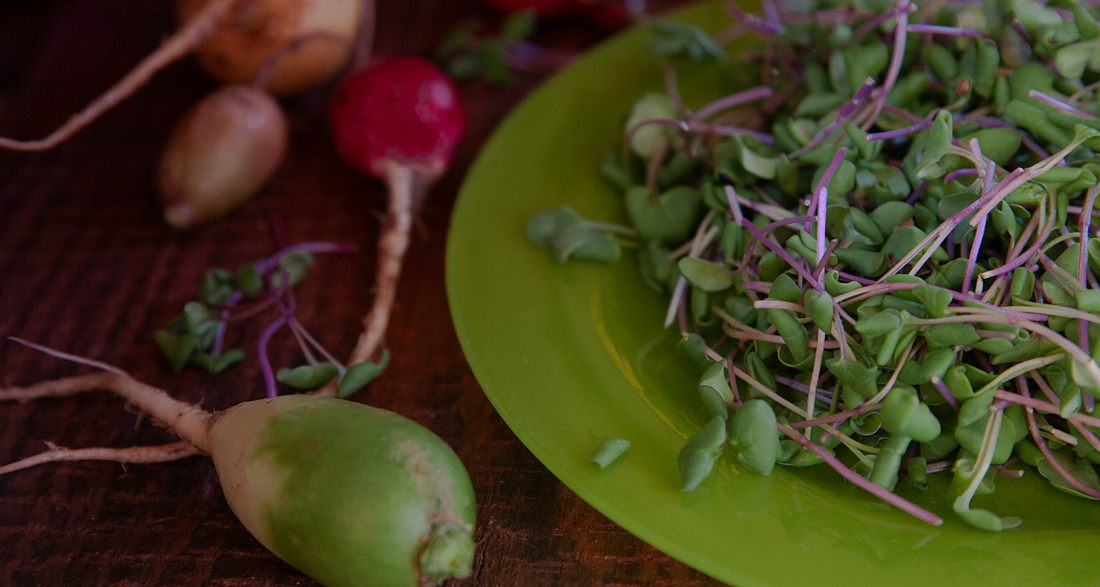
Peppery Powerhouses: Unlocking the Potential of Radish Microgreens
Radish microgreens—mere days‑old seedlings harvested just as the first true leaves unfurl—have rapidly become one of the most coveted green accents in contemporary cuisine. Their appeal is obvious at first glance: the snow‑white stems of the Daikon variety, the deep‑purple tones of Rambo and the rosy petioles of China Rose instantly brighten any plate, while beneath their delicate surface lies an impressive store of nutrients. Comparative analyses show that 100 grams of fresh radish microgreens contain between thirty‑nine and fifty‑six milligrams of vitamin C—almost half of an adult’s daily requirement and more than twice the content of mature radish roots . The contrast is even starker for vitamin E: tiny China Rose leaves reach tocopherol levels unimaginable in a root harvested after months in the ground .

This “miniature” form of the plant also supplies noteworthy amounts of niacin, pyridoxine and folate, thereby supporting the nervous system and blood formation. On the mineral side it is rich in potassium—crucial for blood‑pressure regulation—as well as calcium and iron. Strikingly, bioavailability trials show that these minerals are absorbed from radish microgreens more efficiently than from any other Brassicaceae microgreen studied so far . At the same time the young leaves accumulate carotenoids and polyphenols, together with the sulfur‑rich glucosinolates that typify the cabbage family. Chewing or chopping activates myrosinase, which converts those compounds into isothiocyanates; laboratory work has demonstrated that such extracts inhibit the proliferation of breast and colorectal cancer cells .

The dense phytochemical cocktail translates into a persuasive health profile. A potent blend of vitamin C, tocopherols and anthocyanins reduces oxidative stress, strengthens capillary walls and boosts immune resilience while tempering chronic inflammation. The peppery essential oils stimulate gastric secretions, and soluble fibre supports intestinal motility. Add organic sulfur—vital for keratin synthesis—to the mix, and micro‑radish becomes an unassuming yet highly effective nutritional supplement, entirely free of pills or powdered extracts.

Equally compelling is the sensory dimension. Daikon contributes a sharp horseradish‑like jolt; just a few leaves can stand in for hot spice. Rambo offers a deep, long‑lasting pepper bite with a hint of bitterness, creating welcome contrast to creamy sauces, while China Rose tempers the blend with a trace of sweetness: its heat is unmistakable, but it fades quickly, leaving a gentle floral echo. Together, the three cultivars build a multi‑layered pungency that ranges from an immediate sting on the tongue to a fragrant, aromatic finish.

In the kitchen, radish microgreens function as far more than a garnish. Chefs finish pale cream soups with their vivid flecks of colour and texture, while street‑food tacos al pastor gain extra juiciness and a natural salsa‑like kick from a sprinkle of micro‑radish. On a refined tuna carpaccio, purple Rambo leaves amplify the fish’s sweetness and the salty note of capers, whereas in a smoothie bowl a handful of seedlings replaces ginger, offering half a day’s worth of ascorbic acid. The same pepperiness cuts through the buttery richness of a hollandaise, which is why Daikon microgreens now grace brunch‑time eggs Benedict in an ever‑growing number of venues.
Despite their sophistication, these greens are straightforward to handle. Stored at 0–5 °C in high humidity, they remain crisp for up to a week. They should be rinsed only just before use—prolonged soaking reduces vitamin C content—and ideally added at the last moment to preserve their snap. The sole caveat concerns people allergic to brassica plants: although dedicated facilities rule out cross‑contaminants, radish itself can trigger reactions in sensitive consumers.

At a time when gastronomy seeks to fuse aesthetic flair with functional nutrition, miniature radish leaves prove indispensable to cooks and dietitians alike. They contribute colour, texture and an assertive flavour while delivering a concentrated shot of vitamins, minerals and scientifically documented protective compounds. If one were to stock only a single spicy microgreen—whether in a home refrigerator or a professional cold pass—the radish seedling is the obvious choice, uniting pleasure for the palate with tangible benefits to health.
